With the fall semester in sight, college and university foodservice operators find themselves evaluating what worked and what didn’t during the previous academic year as they prepare for the new school year. While they hope for more normal foodservice programs, many changes from the past year may remain.
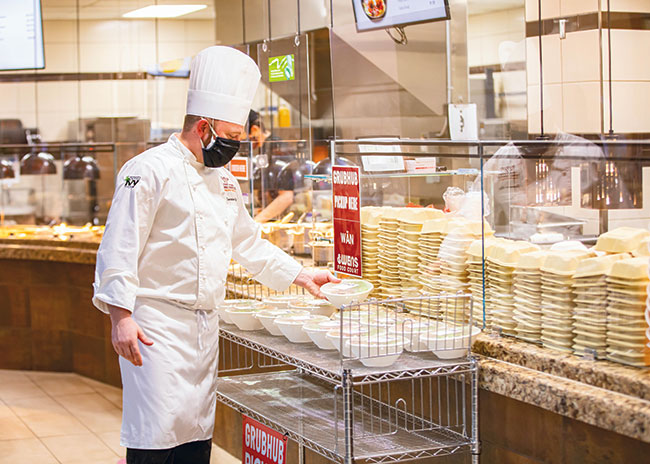 Virginia Tech, like other college foodservice operators, adapted during the pandemic and may continue new approaches in the fall of 2021. Photo by Darren Van Dyke, Dining Services Photographer/Videographer
Virginia Tech, like other college foodservice operators, adapted during the pandemic and may continue new approaches in the fall of 2021. Photo by Darren Van Dyke, Dining Services Photographer/Videographer
On the going-nowhere list on campuses: mobile ordering and walkup/pickup (curbside pickup is less common on campuses). Combined with this will be a move to more touchless technology, says Orlynn Rosaasen, director of dining services at the University of North Dakota in Grand Forks and the current president of the National Association of College and University Foodservice (NACUFS). “It will be used wherever we can — soft-serve dispensers, utensil dispensers, beverage dispensers — to cut down on contact surfaces.” This can cut down on labor, too, he points out.
Andrew Watling, associate director of dining services at Washington University in St. Louis, thinks students will have a foodservice experience in the fall that’s “closer to normal, but I don’t expect it will be 100%.” Mobile ordering and pickup will be slightly less than the current 60% of orders, he expects.
And though they’re not touchless, Rosaasen believes campus foodservice operations will include more kiosks because they keep labor down, as well as human contact. Another huge advantage of kiosks is they tend to drive check averages up, due to on-screen prompts for customizing. These increases can be significant. “You’ll easily recoup the cost of implementing a kiosk,” he points out.
The University of Oregon in Eugene, Ore., added kiosks in spring 2020, early in the pandemic, out of necessity. “They were very good for transitioning people to mobile ordering,” says Tom Driscoll, director of dining services. “They work like your phone, so if you place an order on the kiosk the first time, you’re in the system, and most people transition to doing it on their phone once they understand how it works.”
Even though the University of Oregon only leased the kiosks, Driscoll doesn’t see them going anywhere because mobile ordering will remain. He added one or two to each foodservice location, both residential and retail. “The kids transitioned to them very quickly,” he says. “I’ll never be able to go back.”
Order Pickup
To keep food at a safe temperature, colleges and universities have been adding pickup stations with ambient and heated shelving and cubbies. At Washington University, all mobile order pickup currently happens at a central location in the main dining hall since all other dining options are nearby. Watling is trying to bring pickup back to each location once he figures out how he wants to hold the food, and he thinks heated shelves are key.
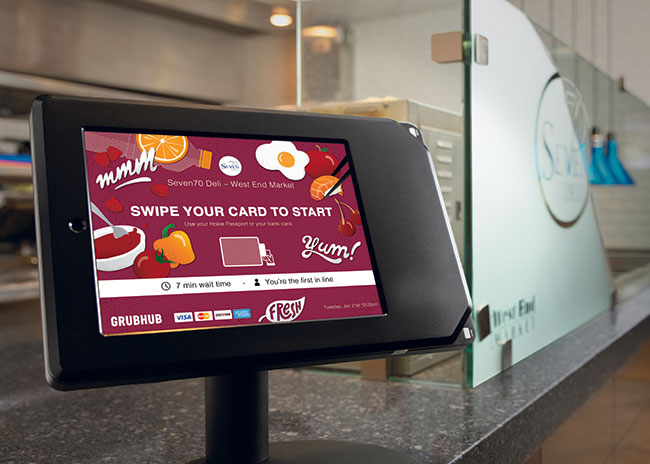 Virginia Tech has created a second makeline in some locations, exclusively for mobile orders. Photo by Darren Van Dyke, Dining Services Photographer/ Videographer
Virginia Tech has created a second makeline in some locations, exclusively for mobile orders. Photo by Darren Van Dyke, Dining Services Photographer/ Videographer
The school has been using heated shelves in the past year “though they’re a little unsightly,” says Watling, because “they’re large and in most locations they sit on top of the counters, which gets in the way of the sightlines we developed and blocks the staff from the guests. We’re figuring out where to deploy them and not have them detract from the in-person experience.”
So far, Watling has stayed away from cubbies due to the expense. “Heated shelves are significantly cheaper and a bit more modular by their nature, and you have access to different sizes — from three to five shelves — so they can go in more places and are much more flexible,” he says.
The University of Oregon has also opted for shelving and added metal racks — ambient — at each location with a sign denoting them as pickup stations. Each one sits outside its designated location in a highly trafficked area. The great thing about these, says Driscoll, is if mobile ordering wanes, the shelves could have many different uses since they’re so generic, but especially for dry storage rooms. They were also “a fairly low investment,” he says.
Boston College in Chestnut Hill, Mass., made the leap to lockers during the COVID-19 pandemic. One popular location on campus, Hillside Café, “which cranked during normal times, with lines out of the door,” remained closed at the beginning of the fall semester because the location was too small to safely admit customers, says Cal Brokamp, purchasing and vendor relations manager. That location stayed closed until she brought in 32 ambient lockers.
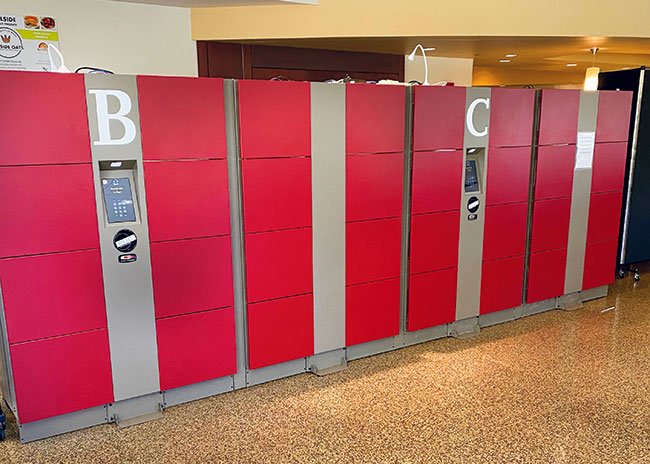 The lockers at Boston College are such a hit that the college will retain them post-COVID-19.
The lockers at Boston College are such a hit that the college will retain them post-COVID-19.
“It immediately took off before we could even fully install the lockers. It was a huge hit, and it really helped boost student morale and student perception of what we were doing because we could expand and grow and serve what they wanted from Hillside Café,” Brokamp says. “Eighty percent of students pick up their food within two minutes of us putting it in the locker. They also know when to order so it comes between classes, so temperature control wasn’t a concern.”
 Washington University in St. Louis is considering different holding options for foodservice pickup, including heated shelves.Boston College will retain these lockers post-pandemic since it had been considering them before the arrival of COVID-19. “The no-contact trend has been growing even without pandemic conditions,” Brokamp says. “We love that we can move them across campus to fit different operations and look forward to finding new ways to use them. They might live at Hillside, or they might travel.”
Washington University in St. Louis is considering different holding options for foodservice pickup, including heated shelves.Boston College will retain these lockers post-pandemic since it had been considering them before the arrival of COVID-19. “The no-contact trend has been growing even without pandemic conditions,” Brokamp says. “We love that we can move them across campus to fit different operations and look forward to finding new ways to use them. They might live at Hillside, or they might travel.”
Texas Tech in Lubbock, Texas, also hopes to introduce lockers with clear fronts so students can see inside. The university would use these lockers for retail locations, either all in one central location or at individual concepts. The university is considering both heated and ambient lockers, per Kirk Rodriguez, managing director, hospitality services. There’s also a refrigerated model, he says, “which might break the bank a little bit.”
Until now, Rodriguez says, students have been collecting food from pickup tables. While lockers will replace some of these tables, he plans to improve these areas. “We’re looking at prettying up these areas with nicer counters, with electricity, with sneeze guards, so it looks like part of the operation,” he says. Texas Tech has converted some cashier stands that Rodriguez describes as “nicely built and lighted” into pickup stations for a more upscale appearance, he points out.
Salad Bar Solutions
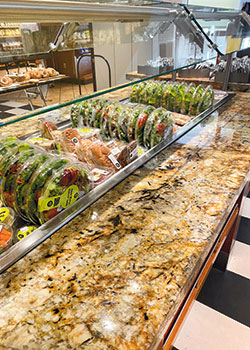 Boston College repurposed its salad bars to store grab-and-go foods.Perhaps the hardest hit area of any foodservice operation since the COVID-19 pandemic began has been the salad bar. Some of these have been closed down, while other operators have shifted to offering prepared salads or have moved them to other concepts. Some schools have been particularly innovative and used the salad bars for something completely different.
Boston College repurposed its salad bars to store grab-and-go foods.Perhaps the hardest hit area of any foodservice operation since the COVID-19 pandemic began has been the salad bar. Some of these have been closed down, while other operators have shifted to offering prepared salads or have moved them to other concepts. Some schools have been particularly innovative and used the salad bars for something completely different.
Rosaasen at the University of North Dakota has high hopes for salad bars coming back, though he admits it could vary from school to school and state to state. He plans to add plexiglass barriers above breath guards, and have employees frequently change the serving utensils.
Stu Orefice, a senior consultant with Envision Strategies in Denver and the former executive director of dining at Princeton University, thinks it will be another year or two before salad bars return. In the meantime, he sees colleges having employees serve the salads, either directly from a serving line or from a designated station. The downside is the increase in labor, and because of this, he says it’s imperative that some kind of self-service model return. He has also seen operators using salad bars to display food or merchandise or even to hold food for pickup.
Boston College has done exactly that. “We’re using the salad bar equipment to store grab-and-go foods, menus that change from breakfast, lunch and dinner, and they’re great for merchandising,” Brokamp explains.
Instead of visiting the salad bar, Boston College students can opt for salads in grab-and-go areas, which now includes a wider selection, or make use of “toss it” made-to-order stations, which are much busier than before the pandemic. And while there has been a drop in salad purchases over the past year, “the ‘toss it’ stations are keeping students interested and engaged,” says Brokamp.
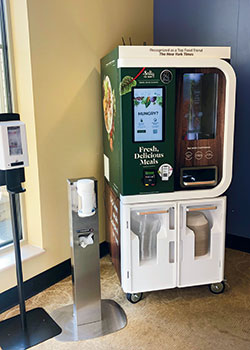 Salad sales are slightly up at Washington University since the campus introduced a robotic salad machine.Back in St. Louis, Washington University’s Watling is not optimistic about salad bars’ return and has implemented three robot salad machines close to the largest c-store on campus. These units allow the university to sell around the same number of salads as it sold from the former salad bar, even with fewer students on campus, and revenue is slightly higher.
Salad sales are slightly up at Washington University since the campus introduced a robotic salad machine.Back in St. Louis, Washington University’s Watling is not optimistic about salad bars’ return and has implemented three robot salad machines close to the largest c-store on campus. These units allow the university to sell around the same number of salads as it sold from the former salad bar, even with fewer students on campus, and revenue is slightly higher.
And the robotic units don’t require a lot of maintenance, Watling says. “They have to be filled when product runs out, and occasionally a product will get stuck and require some help.” He’s also running some specials through the machines, including a Ramadan special this spring that the manufacturer developed specifically for the Washington University campus.
“We haven’t done a lot of specials with them, though,” Watling adds. “When we first introduced [the salad machines] we tried a lot of different specials and unique menu combinations. During the fall semester we quickly learned that the classics were by far the most popular.”
Catering Conundrums
Self-service will likely remain a thing of the past for still some time, but Rosaasen believes we may see a return to sit-down served events. Packaged food will likely emerge as the most popular choice for a while. Food that’s packaged, however, brings challenges for transportation, he points out.
“It requires larger vehicles when you’re prepacking equipment rather than taking it somewhere to serve.”
Texas Tech’s Rodriguez doesn’t think he’ll see a lot of catering until close to the holidays at the end of this calendar year, but he expects to have made significant strides by spring 2022. He’ll buy more breath guards, gloves and sanitation stations for guests, as well as utensils like tongs so there are enough for one pair per guest. For inside events these will be reusable; outside they’ll be disposable.
Washington University has done almost no catering this past year, but “looking forward, we are anticipating a significant switch to grab-and go-style catering, rather than buffets, so we’ll have to adjust our equipment to allow for individual serving displays,” Watling says.
During the pandemic, Washington University made strides with a reusable box program for student meals. The containers feature the school logo and messaging. Watling says the biggest challenge is getting students to return them. Return spots exist around the campus. It only takes nine to 10 uses before a container becomes “financially beneficial,” he points out. “It also makes environmental sense.”
Boston College’s Green2Go reusable container program launched before the pandemic. “We wanted to provide students with flexibility,” Brokamp says. “Whether headed back to their dorm room, eating in a study area or dining in, we wanted to make sure they could do so while focusing on sustainability, food quality and sanitation.”
The campus uses a three-compartment hinged container. Around 200 students paid $9 to join the program this semester, and about 30 are used daily.
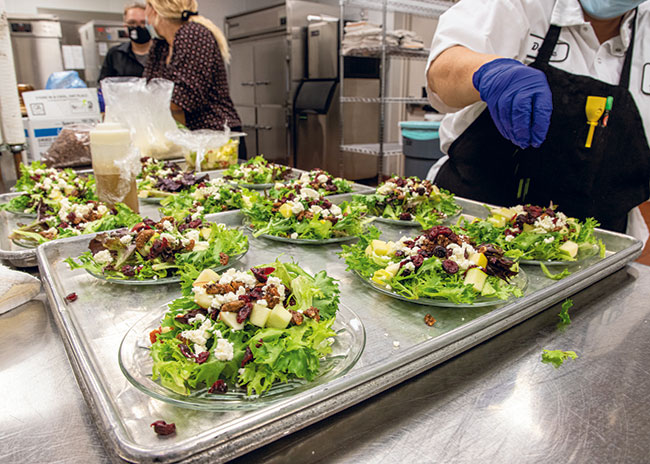 Catering programs, like this one at the University of North Dakota, will likely move to more packaged options when catering operations start back up.
Catering programs, like this one at the University of North Dakota, will likely move to more packaged options when catering operations start back up.
BOH Workflow Adjustments
Virginia Tech in Blacksburg, Va., has redesigned the back-of-the-house at its Qdoba branded location and at Owens Food Court to create a second makeline exclusively for mobile orders. The lines were created using existing equipment. Ironically, the two lines have been less needed during COVID-19, since almost all orders were mobile, so one line was sufficient.
This “relieves the stress of preparing mobile orders and in-person orders for our staff,” says Brian Grove, associate director of dining services. “It speeds up the service for guests that decide to place their orders in person due to not being placed in queue with mobile orders. The mobile order staff are dedicated to producing orders as soon as the ticket comes in,” he says. After the pandemic Qdoba staff will continue the practice during peak business times.
Watling also had to adjust the workflow at Washington University’s back-of-the-house stations in order to combine an in-person order stream with the mobile order stream. “In a few locations we have had the space to create a second production line to produce mobile orders exclusively,” he points out. Washington University’s commissary is also producing key items in large quantities “so smaller service station cooking areas can accommodate the quick surge in orders that comes with mobile ordering.”
Due to the enormous increase in pickup orders, Texas Tech created packaging expediting stations in the back of the house in many of its locations. “We just carved it out of what we already had and didn’t really spend any money,” says Rodriguez. Mostly, he just moved things around or removed equipment, but “we had to create an area to hold those packages and bags,” he explains.
Also in the back of the house, Grove seeks more versatile equipment, such as a combi oven. “A combi oven has a higher price tag, but it can provide so many different cooking methods in one piece of equipment. It assists with the number of pieces of equipment needed, plus helps with staffing,” he points out.
College and university foodservice is going to look very different in the fall, but one thing’s for sure: These operators will continue to innovate and experiment and find the best ways to serve students.



